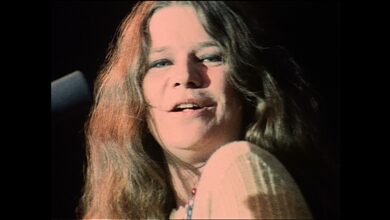The Temptations Delivered A Timelessly Soulful Performance Of “My Girl”
In the annals of music history, few songs have achieved the enduring charm and universal appeal of “My Girl” by The Temptations. Released on December 21, 1964, this soulful ballad not only became the group’s first number-one hit but also solidified their place as icons of the Motown era. The story behind “My Girl” is a tapestry woven with talent, serendipity, and the collaborative spirit that defined a generation of music.
The genesis of “My Girl” can be traced back to the creative genius of Smokey Robinson, a pivotal figure at Motown Records. Robinson, along with fellow Miracle member Ronald White, penned the song with a specific vision in mind. Inspired by his wife, Claudette Rogers Robinson, Smokey sought to craft a melody that encapsulated the warmth and affection of true love. The result was a composition that would soon become synonymous with The Temptations’ legacy.
At the time, The Temptations were composed of Otis Williams, Melvin Franklin, Paul Williams, Eddie Kendricks, and David Ruffin. While Kendricks and Paul Williams had primarily handled lead vocals, Robinson recognized a unique quality in Ruffin’s voice—a blend of mellowness and grit—that he believed could bring “My Girl” to life. This insight led to Ruffin taking the lead on the track, marking a significant shift in the group’s dynamic.
Recording sessions for “My Girl” took place in the fall of 1964 at the famed Hitsville U.S.A. studio in Detroit. The song’s iconic opening bassline, played by the legendary James Jamerson, coupled with Robert White’s memorable guitar riff, set the stage for Ruffin’s soulful delivery. The synergy between the instrumental arrangement and vocal harmonies created a sound that was both fresh and timeless.
Upon its release, “My Girl” quickly ascended the charts, reaching the pinnacle of the Billboard Hot 100 on March 6, 1965. This achievement was monumental, as it not only marked The Temptations’ first number-one hit but also underscored Motown’s growing influence in the music industry. The song’s success was a testament to the label’s formula of blending catchy melodies with heartfelt lyrics, a strategy that resonated with a broad audience.
The impact of “My Girl” extended beyond commercial success. It became a cultural touchstone, symbolizing the optimism and romanticism of the 1960s. The song’s simple yet profound lyrics, “I’ve got sunshine on a cloudy day,” struck a chord with listeners, offering a sense of comfort and joy. Its universal theme of love made it relatable across different demographics, contributing to its enduring popularity.
In the context of The Temptations’ career, “My Girl” was a catalyst that propelled them to new heights. Following this triumph, the group continued to release a string of hits, including “It’s Growing,” “Since I Lost My Baby,” and “Ain’t Too Proud to Beg,” further cementing their status as R&B legends. David Ruffin’s emergence as a prominent lead vocalist added a new dimension to their performances, characterized by his emotive delivery and charismatic presence.
The song’s influence permeated the music industry, inspiring numerous artists to offer their renditions. Notably, Otis Redding’s 1965 cover introduced “My Girl” to the UK audience, where it reached number 11 on the charts. This cross-Atlantic appeal highlighted the song’s versatility and its ability to transcend cultural boundaries. Over the years, “My Girl” has been covered by various artists, each bringing their unique interpretation while honoring the original’s essence.
Decades after its debut, “My Girl” continues to be a staple in popular culture. Its inclusion in films, commercials, and television shows has introduced the classic to new generations, ensuring its legacy endures. In 1992, following its feature in the film of the same name, the song experienced a resurgence, reaching number two on the UK Singles Chart. This revival underscored its timeless appeal and the emotional connection it fosters with audiences.
The song’s enduring popularity was further evidenced in 2024 when it found a new home in the world of sports. Francisco Lindor, the star shortstop for the New York Mets, adopted “My Girl” as his walk-up song, a choice that resonated with fans. The crowd at Citi Field would often sing along, creating a unifying and uplifting atmosphere. This phenomenon culminated in a special performance by The Temptations during the National League Championship Series, bridging the gap between music and sports in a memorable way.
Reflecting on its legacy, “My Girl” stands as a testament to the power of collaboration and the magic that can emerge when talent converges. The partnership between The Temptations and Smokey Robinson exemplifies the creative synergy that defined the Motown era. The song’s success also highlights the importance of recognizing and nurturing individual strengths within a group, as seen in the decision to feature David Ruffin’s distinctive vocals.
In the broader scope of music history, “My Girl” represents a milestone in the evolution of soul music. Its blend of heartfelt lyrics, harmonious vocals, and innovative arrangements set a standard for future R&B recordings. The song’s ability to evoke emotion and connect with listeners on a personal level is a hallmark of its enduring appeal.
As we look back on the journey of “My Girl,” it is evident that its charm lies not only in its melodic composition but also in the story it tells—a story of love, collaboration, and the timeless human experience. The Temptations, through this song, have left an indelible mark on the tapestry of music, one that continues to inspire and resonate with audiences around the world.



